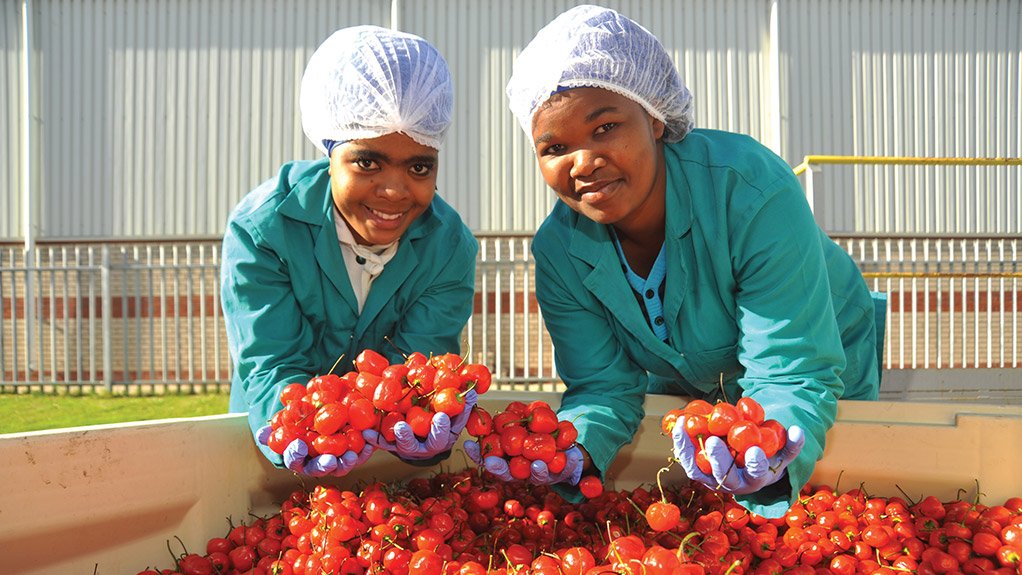To decrease South Africa’s R21-billion trade deficit in agroprocessed goods, production in this area needs to grow in the country, which traditionally uses foreign suppliers to process its produce, adding to the cost of final product for local consumers.
Western Cape Economic Opportunities Minister Alan Winde said in a statement that the need to prioritise the agroprocessing sector was emphasised by the figures contained in the 2015 Bureau for Food and Agricultural Policy (BFAP) Baseline Agricultural Outlook 2015 to 2024, released on July 31 at the Lord Charles Hotel, in Somerset West.
South Africa remained a net importer of major food items such as wheat, rice, vegetable oils and palm oil.
Hence, the depreciation of the exchange rate, which was expected to continue its decline towards R15.80 to the dollar towards 2024, had a direct impact on import parity prices and, thus, the affordability of these food items for poor consumers. “This is not an uncommon scenario in developing economies,” the report stated.
Winde pointed out that when researchers studied the National Department of Agriculture, Forestry and Fisheries figures on the average import versus export values between 2006 and 2010, they noted a major deficit.
“Part of our strategy to grow the size of the agroprocessing sector is looking at how we can reduce imports, where possible, by promoting local products. With the cost of healthy eating increasing, opting for local produce will give consumers welcome relief,” he commented.
The report noted that if the country’s economy grew strongly and jobs were created, the impact of food inflation could be absorbed by a large share of the population.
However, the South African economy was forecast to expand by a mere 2% this year, reflecting the impact of unemployment, industrial action and challenges in energy supply.
“Over the longer term, the [International Monetary Fund] projects that growth will accelerate to 3.5%,” stated the BFAP Baseline.
As such, the report estimated that South Africa’s food demand over the next ten years would, in general, not increase at the same rate as the last ten years, when South Africa managed to maintain a positive class mobility rate.
Subsequently, the share of the population in the lower income categories reduced significantly, as South Africans moved into a higher income bracket, resulting in a sharp rise in food demand.
However, from 2015 to 2024, this trend would slow, as the dampened economic growth rate had already taken its toll on the country’s class mobility rates, decreasing the rate at which consumers were shifting to higher income categories.
“This will have a trickle-down effect throughout the food system right to the farmer, where profit margins will be tighter and the environment will become more competitive,” it added, noting the highest-ever real net farm income was recorded in 2014.
The BFAP Baseline also noted that the cost of healthy eating was climbing faster than inflation in South Africa. Between January 2011 and April 2015, the cost of a healthy eating plan for a family of four rose by 36%.
Household income was also increasing, but so were debt levels. While the average household income increased from R6 928 in 2009 to R10 525 in 2014, in the fourth quarter of 2014, 44% of credit facilities were granted to consumers with less than R5 500 income per month. These credit grants contributed about 13% in value terms.
The number of credit accounts increased by 18.5% from early 2009 towards the fourth quarter of 2014, while the number of rejected credit applications rose to 53.5% in 2014, compared with 43.9% in 2009.
The report noted that inadequate household income was a major contributor to food insecurity among South Africa’s economically marginalised households. “These households are highly dependent on bought food, due to factors such as a lack of land, capital and tools, livestock, literacy and other formal skills.”
Furthermore, the variety of foods available to marginalised households was also limited. Their reliance on bought food, coupled with inadequate household income levels also exposed households to inflation and food price shocks.
The impact of the hike in electricity tariffs on households’ food choices was also illustrated in the 2015 report as researchers reviewed the results of focus groups held by the Pietermaritzburg Agency for Community Social Action.
More consumers were moving away from maize meal to rice, because rice had a shorter cooking time. However, maize meal is fortified and has greater nutritional value compared with rice, Winde noted, adding that the price of rice is likely to increase as the rand depreciates, which will put additional pressure on lower income families.
“Researchers . . . revealed that electricity cost increases were changing the eating habits of residents in lower income households,” Winde explained.
He added that the 2015 BFAP Baseline was an excellent tool for both the private and public sector.
“The report clearly shows the importance of trade with the rest of Africa. In 2014, South Africa’s exports of agricultural products were worth R104-billion. African markets are a key driver of this growth. Over the past 13 years, our exports to Africa grew by 14% compared with the European Union, which saw an 8% increase,” Winde noted.
The study – which provided projections for key sectors, including meat, milk and dairy products, wine, sugar and grains – allowed patterns like these to be mapped to assess whether the country’s programmes were responsive to global trends.
“I would like to encourage the private sector to consider this report in making their own plans,” Winde said.
The 2015 edition of the BFAP Baseline presents an outlook of agricultural production, consumption, prices and trade in South Africa for the period 2015 to 2024 and relates these results to policy and decision-making in a turbulent macroeconomic environment.
EMAIL THIS ARTICLE SAVE THIS ARTICLE
To subscribe email subscriptions@creamermedia.co.za or click here
To advertise email advertising@creamermedia.co.za or click here











